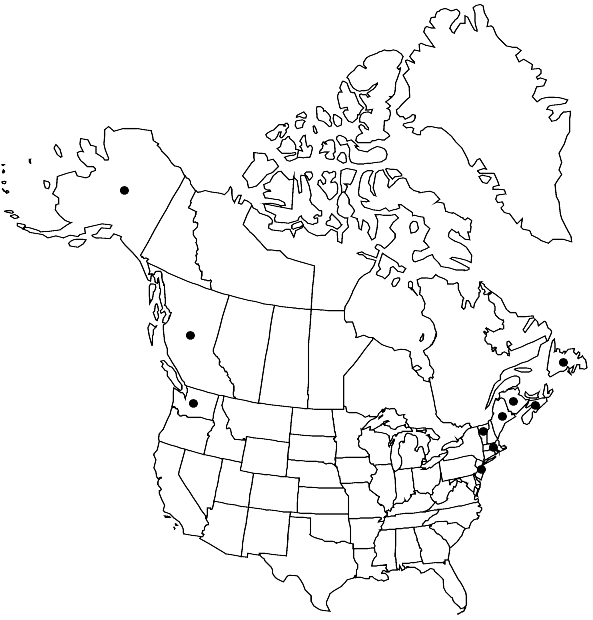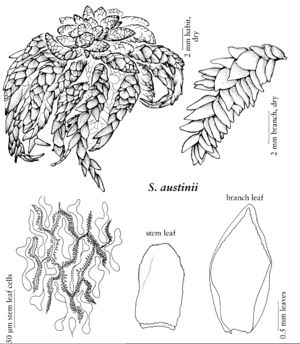Sphagnum austinii
in C. F. Austin, Musci Appalach., 2. 1870 (as austini),.
Plants moderate-sized to large, usually quite compact; reddish brown and often yellow flecked with red-brown; in dense stands forming large and tall hummocks. Stems brown, superficial cortical cells with spiral reinforcing fibrils clearly visible, usually 2 or more pores per cell, comb-fibrils lacking on interior wall. Stem leaves 1.2–1.6 × 1 mm; rarely hemiisophyllous; hyaline cells nonseptate or more typically mostly septate, comb-lamellae present on interior wall. Branches clavate, tapering to short point, tightly imbricate at proximal end to somewhat spreading at distal end in less compact forms. Branch fascicles with 2 spreading and 1 pendent branch. Branch stems with cortical cell comb-lamellae visible on interior wall, conspicuous funnel-like projection on interior end walls extending to next cell less than one half its length, pores in superficial wall restricted to leaf bases. Branch leaves ovate-elliptical to elliptical, 1.5–2.1 × 0.8–1.4 mm; hyaline cells on convex surface with numerous moderate-sized round pores along the commissures, comb-lamellae present throughout most of leaf; chlorophyllous cells broadly triangular in transverse section and well-enclosed on the convex surface, end wall not thickened. Sexual condition dioicous. Capsule with scattered pseudostomata. Spores 23–28 µm; coarsely granulate on both surfaces; proximal laesura more than 0.50 spore radius.
Phenology: Capsules common, mature mid summer.
Habitat: Ombrotrophic mires and large hummocks in blanket mires
Elevation: low to moderate elevations
Distribution

B.C., N.B., Nfld. and Labr. (Nfld.), N.S., Alaska, Maine, Mass., N.J., Vt., Wash., Europe.
Discussion
Sphagnum austinii is usually easily recognized in the field by its strongly imbricate and clavate branches. It forms very dense and often tall hummocks with a distinct deep golden brown color. In contrast to the view stated by H. A. Crum (1997), this species has an ecology and distribution quite distinct from those of S. affine. Sphagnum affine is a minerotrophic species that does not even occur in the Pacific coast region, where S. austinii is quite prominent.
Selected References
None.
